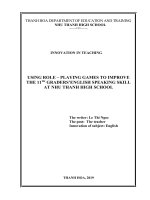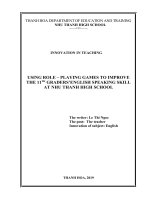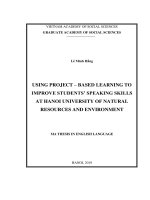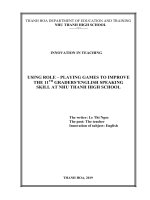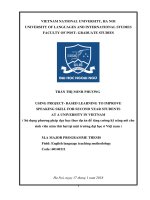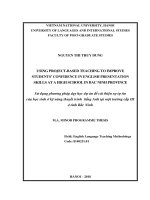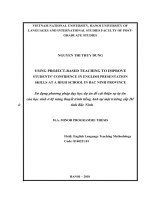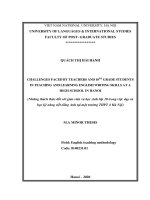Using project based teaching to improve students’ confidence in english presentation skills at a high school in bac ninh province
Bạn đang xem bản rút gọn của tài liệu. Xem và tải ngay bản đầy đủ của tài liệu tại đây (1.24 MB, 70 trang )
VIETNAM NATIONAL UNIVERSITY, HANOI
UNIVERSITY OF LANGUAGES AND INTERNATIONAL STUDIES
FACULTY OF POST-GRADUATE STUDIES
NGUYEN THI THUY DUNG
USING PROJECT-BASED TEACHING TO IMPROVE
STUDENTS’ CONFIDENCE IN ENGLISH PRESENTATION
SKILLS AT A HIGH SCHOOL IN BAC NINH PROVINCE
Sử dụng phương pháp dạy học dự án để cải thiện sự tự tin
của học sinh ở kỹ năng thuyết trình tiếng Anh tại một trường cấp III
ở tỉnh Bắc Ninh
M.A. MINOR PROGRAMME THESIS
Field: English Language Teaching Methodology
Code: 8140231.01
HANOI – 2018
VIETNAM NATIONAL UNIVERSITY, HANOI
UNIVERSITY OF LANGUAGES AND INTERNATIONAL STUDIES
FACULTY OF POST-GRADUATE STUDIES
NGUYEN THI THUY DUNG
USING PROJECT-BASED TEACHING TO IMPROVE
STUDENTS’ CONFIDENCE IN ENGLISH PRESENTATION
SKILLS AT A HIGH SCHOOL IN BAC NINH PROVINCE
Sử dụng phương pháp dạy học dự án để cải thiện sự tự tin
của học sinh ở kỹ năng thuyết trình tiếng Anh tại một trường cấp III
ở tỉnh Bắc Ninh
M.A. MINOR PROGRAMME THESIS
Field: English Language Teaching Methodology
Code: 8140231.01
Supervisor: Assoc. Prof. Dr. Pham Thi Thanh Thuy
HANOI – 2018
DECLARATION
I, the undersigned, declare that this thesis is the result of my own research and has
not been submitted to any other university or institution partially or wholly. Except
where the reference is indicated, no other person’s work has been used without due
acknowledgement in text of the thesis.
Hanoi, 2018
Student
Nguyễn Thị Thùy Dung
i
ACKNOWLEGEMENTS
In the process of implementing my thesis, I have received lots of help,
encouragement and experiences from teachers and friends.
First of all, I would like to express my gratitude to my supervisor Assoc. Prof. Dr.
Pham Thi Thanh Thuy who has generously given me invaluable assistance and
guidance. Without her help, my research would have never been successfully
completed.
Besides, my sincere thank is also extended to all the teachers in Post-graduate
Department, Ha Noi University of Language and International Studies for their
lectures supporting this research; simultaneously, my thank to all the students who
helped me take part in the research and fulfill the questionnaire.
Last but not least, I am grateful to my family and friends who have given me much
encouragement during the time I carry out this research.
ii
ABSTRACT
It is obvious that project-based learning plays an important role in language
teaching and learning. This thesis was conducted with the aims to find out the
reasons why students lack confidence in presentations, explore students’ and
teacher’s attitudes toward the project-based learning, and explore how the projectbased learning lessons help improve ten – grade students’ confidence in English
presentation skills.
The study was conducted as an action research focusing on improving ten –
grade students’ confidence in English presentation skills at a High School in Bac Ninh
province by using project-based learning. It includes 48 ten – grade students who are
in the second semester of school year 2017 – 2018.
Hopefully, the results of the study can help students improve their confidence
in English presentation skills in future and teachers apply project-based learning in
their language teaching.
iii
ABBREVIATION
PBL: Project-based learning
iv
TABLE OF CONTENTS
DECLARATION ........................................................................................................ i
ACKNOWLEGEMENTS.........................................................................................ii
ABSTRACT ............................................................................................................. iii
ABBREVIATION .................................................................................................... iv
TABLE OF TABLES ............................................................................................ viii
TABLE OF FIGURES, CHARTS .......................................................................... ix
PART A: INTRODUCTION .................................................................................... 1
1. Rationale of the study.............................................................................................. 1
2. Aims of the study .................................................................................................... 2
3. Research questions .................................................................................................. 2
4. Significance of the study ......................................................................................... 2
5. Scope of the study ................................................................................................... 3
6. Methods of the study ............................................................................................... 3
7. Design of the study.................................................................................................. 4
PART B: DEVELOPMENT..................................................................................... 5
CHAPTER 1: LITERATURE REVIEW ................................................................ 5
1.1. Presentation skills................................................................................................. 5
1.1.1. Definitions of presentation ................................................................................ 5
1.1.2. Types of presentation ........................................................................................ 5
1.1.3. Criteria for a good presentation ........................................................................ 6
1.1.4. The importance of presentation skills in language learning ............................. 7
1.2. Confidence ........................................................................................................... 8
1.2.1 Definitions of confidence ................................................................................... 8
1.2.2. The importance of confidence in presentation skills ........................................ 9
1.3. Project-based learning (PBL) ............................................................................. 12
1.3.1. Definitions of PBL .......................................................................................... 12
1.3.2. Salient features of PBL ................................................................................... 12
v
1.3.3. Benefits of PBL ............................................................................................... 13
1.3.4. Types of PBL .................................................................................................. 14
1.3.5. A framework for PBL ..................................................................................... 15
1.3.6. The role of the teacher in PBL ........................................................................ 18
CHAPTER 2: METHODOLOGY ......................................................................... 21
2.1. Action research ................................................................................................... 21
2.1.1. Definition of action research ........................................................................... 21
2.1.2. The process of action research ........................................................................ 21
2.1.3. Rationale of using an action research ............................................................. 23
2.2. Context of the study ........................................................................................... 24
2.3. Participants ......................................................................................................... 24
2.4. Data collection ................................................................................................... 25
2.4.1. Questionnaire .................................................................................................. 25
2.4.2. Teacher’s observation ..................................................................................... 25
2.4.3. The pre-test and post-test ................................................................................ 25
2.5. Data analysis ...................................................................................................... 26
2.6. The action research procedure ........................................................................... 26
2.6.1. Initiation (week 1, 2) ....................................................................................... 26
2.6.2. Primary investigation (week 3, 4) ................................................................... 26
2.6.3. Hypothesis ....................................................................................................... 26
2.6.4. Intervention (Implementing PBL in form of group-work in afternoon tutor
lessons) (week 5, 6, 7, 8, 9, 10, 11, 12) ..................................................................... 26
2.6.5. Evaluation (week 13 - 15) ............................................................................... 29
2.6.6. Dissemination .................................................................................................. 29
2.7. Summary ............................................................................................................ 29
CHAPTER 3: FINDINGS AND DISCUSSION ................................................... 30
3.1. Factors affecting students’ lack of confidence in English presentation skills ... 30
3.1.1. Internal factors ................................................................................................ 30
3.1.2. External factors ............................................................................................... 34
vi
3.2. Attitudes of students and teachers to project-based learning ............................. 35
3.2.1. Attitude of students ......................................................................................... 35
3.2.2. Attitude of teacher ........................................................................................... 37
3.3. Effect of project-based learning ......................................................................... 38
3.3.1. Effect of project-based learning in presentation skills .................................... 38
3.3.2. Effect of project-based learning in improving confidence in presentation skills ... 39
3.4. Summary ............................................................................................................ 41
PART C: CONCLUSION....................................................................................... 42
1. Summary of the study ........................................................................................... 42
2. Major findings and discussion of the study .......................................................... 42
3. Limitations of the study ........................................................................................ 44
4. Suggestions for further studies .............................................................................. 44
REFERENCES ........................................................................................................ 46
APPENDICES ........................................................................................................... I
Appendix 1 .................................................................................................................. I
Appendix 2 ................................................................................................................. V
Appendix 3 ................................................................................................................VI
Appendix 4 ............................................................................................................. VIII
vii
TABLE OF TABLES
Table 1.1: Summary of criteria for a good presentation ............................................. 7
Table 2.1: Project topics ............................................................................................ 28
Table 3.1: Students’ result in the pre-test of presentation......................................... 33
Table 3.2: Students’ feeling about topics of project carried out in the semester ...... 36
Table 3.3: Students’ result in the post-test of presentation ....................................... 40
viii
TABLE OF FIGURES, CHARTS
Figure 2.1: Steps in the action research cycle ........................................................... 22
Chart 3.1: The role of presentation skills .................................................................. 30
Chart 3.2: Students’ interest in English presentation skills in class ......................... 31
Chart 3.3: Factors causing students’ lack of confidence in English presentation
skills .......................................................................................................................... 32
Chart 3.4: Teacher’s guide ........................................................................................ 34
Chart 3.5: Factors motivating students’ confidence in English presentation............ 35
Chart 3.6: Effect of PBL in presentation skills ......................................................... 38
Chart 3.7: Effect of project-based learning in improving confidence in presentation
skills .......................................................................................................................... 39
ix
PART A: INTRODUCTION
1. Rationale of the study
In this globalization era, the importance of English is widely recognized
since it is a mean of international communication; therefore, it is used through the
world. In Vietnamese education reform recent years, English national curriculum
has been focused on developing English language competence which is expected in
all four of the following skills: listening, reading, writing, especially speaking. One
of the most important parts of speaking skills is presentation skills. Joan Van
Emden, Lucinda M. Becker (Palgrave Macmillan, 2004, p.142): "The ability to
present a case clearly, cogently and confidently is enormously valuable at every
stage of student's lives, whatever the subjects they study; it will bring them success
in academic work, job interviews and their future working life - it's the most
transferable of all their skills and a critical part of their professional development."
Recognizing of the importance of developing English language competence
for students, High Schools in Bac Ninh province have implemented in the system of
seven – year English course books 10, 11, 12 to help students master four skills:
listening, reading, writing, and speaking. Experiencing five years teaching these
course book programs, the researcher noticed the fact that one obvious and
continuous weakness of most students is limited speaking skills, especially
presentation skills. Many students feel shy to present in front of other people. The
most serious problem is the lack of confidence.
Meanwhile, the researcher considered project-based learning approach (or
project-based teaching) as an appropriate and effective way to help students
overcome the difficulties in speaking skills and increase students’ confidence in
presentation skills. Project-based learning refers to students’ designing, planning,
and carrying out an extended project that produces a publicly-exhibited output such
as a product, publication, or presentation (Patton, 2012). During doing projects,
students have to use English and cooperate with their peers as well as building
1
teamwork, group skills to get the best result in their final presentations. Therefore,
their confidence can be improved in presentation skills. Moreover, students are
encouraged to become independent workers, critical thinkers, and lifelong learners.
Considering the positive contribution of PBL, the researcher conducted a
study on the implementation of project-based learning to improve students’
confidence in English presentation skills at a High School in Bac Ninh province.
2. Aims of the study
With the reason above, this study is aimed at:
- finding out the reasons why students lack confidence in presentations,
- exploring students’ and teacher’s attitudes toward the project-based learning,
- exploring how the PBL lessons help improve ten – grade students’ confidence in
English presentation skills.
3. Research questions
In order to achieve these aims, three following questions were proposed:
(1) What make students feel unconfident in presentation?
(2) What are students’ and teacher’s attitudes toward project-based learning?
(3) To what extent PBL lessons help improve ten – grade students’ confidence in
English presentation skills?
4. Significance of the study
Some studies claimed that PBL has been challenging for teacher to apply in
spite of its positive benefits. PBL may not work well with students who are not
ready to this new approach (Levy, 1997). Teachers may have difficulty in the role
of “facilitator”, especially if they haven’t grasped concept of PBL. In addition, it is
not easy to integrate all of the course material into a single, semester-long project,
so teachers may not success to cover some of the core material for a particular
course. Besides, the group dynamic may make it difficult to determine which
students contributed the most to the project, some students are lazy to cooperate and
work for the final results, thus complicating student assessment. Because of these
potential problems, the researcher wants to provide an understanding into the
2
benefits and effectiveness of applying PBL in English lessons. The study will
consolidate the theoretical understanding of PBL for colleagues and students at the
researcher’s high school. They will have appropriate teaching methods in applying
PBL in their lessons. Moreover, the findings of the study will help the ten-grade
students improve their confidence in English presentation skills by using PBL.
5. Scope of the study
This study mainly focuses on improving ten – grade students’ confidence
in English presentation skills at a High School in Bac Ninh province by using
PBL. It includes 48 ten – grade students who are in the second semester of
school year 2017 – 2018.
Due to the limitation of time and scale of a minor thesis, the study only
focuses on finding out the reasons that make students lack confidence in English
presentations, investigating students’ and teachers’ attitudes toward using PBL and
extent of the project that meets the project aims.
6. Methods of the study
The study was conducted as an action research with four key stages:
Planning, Acting, Observing, and Evaluation:
Stage 1: Planning:
- A pre-test and a questionnaire were used to investigate the issues that make
students lack confidence in English presentation skills. The data collected from the
questionnaires was analyzed qualitatively and quantitatively.
- Mapping out strategies for the lesson plans applied PBL to improve students’
confidence in English presentation skills.
Stage 2: Acting:
- PBL was adopted in the English lessons with fifteen hours over fifteen weeks in
class 10A2 in the second semester of school year 2017 – 2018 with eight topics
based on Basic English Textbook 10 (Hoang Van Van, 2006) to improve their
confidence in presentation skills.
3
Stage 3: Observing:
- An experiencing teacher in English groups of the High School was invited to
observe these lessons and evaluate the changes in the final results.
- Class observation were made carefully and objectively based on the outcomes of
students.
Stage 4: Evaluation:
- A post-test was given for students to evaluate their confidence in English
presentation skills.
- A questionnaire was carried out to get information from students’ and teachers’
attitudes toward using PBL in English lessons.
- Documentary analysis was used to measure what the project met its objectives.
- From the results of the post-test, questionnaire and class observation, some
conclusions were made.
7. Design of the study
The thesis entitled “Using Project-based Teaching to Improve Students’
Confidence in English Presentation Skills at a High School in Bac Ninh Province”
is divided into three parts:
Part A – Introduction shows the rationale, the aims for the research, the research
questions, the significance, the scope, the methods and the design of the study.
Part B – Development consists of three chapters:
Chapter 1 - Literature review includes an overview of background of the study.
This chapter makes clear key concepts and theories of the research topic, and
reviews previous studies of the field to reveal the research gaps which need filling.
Chapter 2 – Methodology introduces the participants, instrumentation, research
process and plan of the action.
Chapter 3 – Findings and discussion gives detailed description of data analysis
and presents some explanations and interpretations of the finding of the study.
Part C – Conclusion summarizes the major findings, shows the limitations of the
study and provides some suggestions for further study.
4
PART B: DEVELOPMENT
CHAPTER 1: LITERATURE REVIEW
1.1. Presentation skills
1.1.1. Definitions of presentation
On website Skillsyouneed, the formal presentation of information is divided
into two broad categories: Presentation Skills and Personal Presentation. These two
aspects are interwoven and can be described as the presentation and practice of verbal
and non-verbal communication. This study describes what an oral presentation is and
defines some of the key terms associated with presentation skills.
In Oxford Advanced Learner’s Dictionary (2005, p.1190), presentation is
defined as the act of showing something or of giving something to someone,
especially as part of a formal ceremony.
Scott (cited in Jing L. 2009, p.4-5):
“Oral presentation tends to present ideas and information in an interactive way…oral
presentation is a particularly effective way to communicate your concept and complex
ideas because the presenter can use overhead projector and other visual aid and the
audience can ask for further clarification.”
In general, a presentation is a mean of communication that can be adapted to
various speaking situations, such as talking to a group, addressing a meeting or
briefing a team.
1.1.2. Types of presentation
According to Whatley R. P., presentation is divided into five main types
named: Informative, instructional, arousing, persuasive, and decision-making.
1. Information presentation: Keep an informative presentation brief and to the point.
Stick to the facts and avoid complicated information.
2. Instructional presentation: Your purpose in an instructional presentation is to give
specific directions or orders. Your presentation will probably be a bit longer,
because it has to cover your topic thoroughly.
5
3. Arousing presentation: Your purpose in an arousing presentation is to make
people think about ascertain problem or situation.
4. Decision-making presentation: Your purpose in a decision-making presentation is
to move your audience to take your suggested action. A decision-making
presentation presents ideas, suggestions, and arguments strongly enough to persuade
an audience to carry out your requests.
5. Persuasive presentation: Your purpose in a persuasive presentation is to convince
your listeners to accept your proposal.
From five types of presentation above, it can be seen that Whatley
characterized them based on the presenter’s purpose. In spite of its own specific
characteristics, they have a common in requirement: Presentations need a clear,
formal and structured organization to deliver the messages to the listeners.
1.1.3. Criteria for a good presentation
To answer the question: “What is a good presentation?”, Powell, M. (1996)
states: “Many thing to contribute the success of a presentation – new and unusual
content, a clear structure, a good sense of timing, imaginative use of visual aids, the
ability to make people laugh…and think. But above and beyond all of these is
enthusiasm.”
However, D’Arcy (1998) only gives five criteria in the set of evaluation to
evaluate a presentation: organization and development of content, delivery, visuals,
voice and volume, and comprehension. He doesn’t emphasize on any elements, put
them in the equal roles.
Despite using different terms for the evaluation criteria, Powell (1996) and D’
Arcy (1998) both consider content and visual aids to contribute a successful
presentation.
6
Table 1.1: Summary of criteria for a good presentation
No
Criteria for a good presentation
Authors/ Researchers
1
New and unusual content
Powell, M. (1996)
2
A clear structure
3
A good sense of timing
4
Imaginative use of visual aids
5
The ability to make people laugh and think
6
Enthusiasm
7
Organization and development of content
8
Delivery
9
Visuals
10
Voice/Volume
11
Comprehension
12
Preparation
The idea from researcher’s
13
Collaboration with peers
experience
D’Arcy (1998)
Because of the ability of participants and the objectives of the
research, the researcher only focused on some criteria as followed:
Table 1.2: Scope of criteria for a good presentation
No
Criteria for a good presentation
1
Preparation
2
Content
3
Collaboration with peers
4
Voice/Volume
5
Time-limit
6
Delivery (Posture and Eye contact)
7
Comprehension
1.1.4. The importance of presentation skills in language learning
Among the many benefit of designing oral presentations for students are
(King J., 2002): bridging the gap between language study and language use; using
7
the four language skills in a naturally integrated way; helping students to collect,
inquire, organize and construct information; enhancing team work; helping students
become active and autonomous learners. Students are involved in their own learning
process as active participants, they are engaged in real-world experience, and they
build creative and critical thinking and problem-solving skills as important
characteristics for success in the 21st century. The final goal is to help students
maximize their potential, both personally and professionally.
In Alshare and Hindi’ study (2004), the importance of presentation skills is
shown that “students are required to present in two classes per semester for an
average of ten minutes … students and instructors agreed that critical objectives of
presentations were to improve communicative skills and to train students to talk to
a group of people.”
In brief, presentation skills play an important role in learning and teaching
foreign language. It consolidates four skills: listening, speaking, reading, writing;
motivates the cooperation in team work; improves critical thinking and problemsolving skills as well as develops the confidence to communicate with other people.
1.2. Confidence
1.2.1 Definitions of confidence
Confidence (in somebody/something) is defined in Oxford Advanced
Learner’s Dictionary as the feeling that you can trust, believe in, and be sure about
the abilities or good qualities of someone or something.
Palmer (2011 – p.1) describes the term as:
The self-reliance is that people have in their own abilities and values. It does
not mean thinking that people are the best at everything; but feeling comfortable
about themselves in something that they have to do.
To sum up, confidence is a belief in your ability to do your best. You don’t have
to be the biggest, the best or the brightest to have confidence. You just have to believe
that you are capable of doing your best. And you have to be willing to take risks.
8
1.2.2. The importance of confidence in presentation skills
As language learners, confidence is one of the principal factors that have
strong influence in the second language achievements.
In language learning, Chen (2003) claims that confidence is a direct factor
that effects students’ spoken English. Similarly, Gander, S. L. (2006, p. 13 -14)
presents that many students feel satisfied and successful because they have achieved
the independence and fluency levels of proficiency which make them feel confident
in their work.
Talking about the role of confidence in presentation, it is said that oral
presentations require courage and confidence from presenters who are in front of
their classmate.
According to Professional Communication Skills Program,
“The Presentation Skills seminar provides participants with the techniques
needed to prepare, plan and deliver professional presentations. The seminar
provides a supportive environment with ample opportunity to practice speaking on a
variety of subjects. Immediate feedback is provided by the facilitator, fellow
participants and through review of recorded practice presentations. Participants
receive individual direction for improving presentation skills, increasing their
confidence and comfort level when in front of an audience.”
Therefore, confidence is considered as the key in presentation skills.
Confident students trust their abilities and they have specific goals in order to be
achieved without worrying about the outcome.
1.2.3. Factors affecting students’ confidence in presentation skills
Students’ confidence in presentation skills is affected by many factors
discussed in the following:
1.2.3.1. Internal factors
a. Students’ language proficiency
Proficiency including skills, ability and experience is a major factor affects
to student’s confidence in oral activity, especially presentation skills. According to
Rob, E. (1985), proficiency can be considered as linguistic competence or
9
communicative competence and second language proficiency is usually evaluated in
relation to native speakers’ proficiency. Scarcella, R. & Oxford, R. (1992) suggest
that linguistic competence consists of vocabulary, grammar structures, and
mechanics (such as basic sound of letters, syllables; the pronunciation of words,
intonation and stress).
For this reason, students’ language proficiency has direct influence on
students’ confidence in presentation skills in case presenting in front of their
classmates, not being able to answer the questions.
b. Students’ attitude
Chandrasegaran, A. (1981) argues that attitude relates to states of emotion
and thought for the English language, the learning of English and the culture of
English-speaking people. Gardner, R. C. and Larmbert, W.E. (1972) point out that
attitude has a close relationship to motivation. Spolsky (1998:23) say that “a
learner’s attitude affects the development of motivation”. Obviously, attitude is an
important part in speaking English in general and in English presentation skills in
particular because it helps students develop their motivation.
c. Students’ psychological factors
Some researchers, such as Nuna, D. (1999) considers “this fear affects to
make mistakes”. Hieu, T. (2011) presents that students fear of being laughed at by
classmates and being criticized by their teachers. T. Kurtus, R. (2001), similarly,
adds that students care about the way other people see them and scare of being look
foolish by other students.
Besides, shyness is a psychological factor affect to students’ confidence
during presenting English. Baldwin, C. (2011) adds that shyness in speaking in
front of many people make mind blank and students may forget what to say. Saurik
(2011) shows that most of students shy in presenting because they think they can
make mistakes when talking.
To sum up, fear of mistakes and shyness in front of others easily lead to lack
of confidence in presentation skills. Moreover, if students feel shy, they usually
make mistakes.
10
1.2.3.2. External factors
a. Inappropriate teacher’s correction and role
Brown, H. D. (2002 – P.205) agrees that students’ errors show their
acquisition about the language in through strategies. Teachers usually correct
students’ errors to help them master the language. Some students feel comfortable
with gender and clever correction while the others prefer frank correction. Ur, P.
(2000) expresses that students may be unconfident and disappointed when teachers
correct their error insensitively or criticize them in front of class. Thus, teacher
should be sensitive, enthusiastic and gentle in giving feedbacks and correction so
that students are easy-going to recognize their errors and present their ideas
confidently.
According to Harmer, J. (1999 – p.57), teachers’ role in classroom can be a
controller, an organizer, an assessor, a prompter, a participant, a recourse, a tutor,
and an observer.
Byme, D. (1986 – p.2) classifies the role of the teachers into three stages:
Firstly, the presentation stage, teachers present the plan, assign tasks and
allocate time.
Secondly, the practice stage, students work in groups under the teachers’
observation and guide.
Lastly, the production stage, teachers encourage students to use the language
freely and comment their performances at the end of the presentations. For this role,
if teachers are enthusiastic and gentle in guiding and giving feedbacks, students are
very confident in their presentation skills.
b. Teachers’ characteristics
Teachers’ characteristics have a great influence on students’ confidence. For
instance, teaching qualifications and competence will help teachers to become more
professional rather than just a teacher. Barry, K. and King, L. (1993) explains that
teachers should be natural, warm, tolerant, pleasant and approachable in order to
build close relationship with students. It can create a comfortable atmosphere in the
classroom and develop students’ confidence in presentation skills.
11
1.3. Project-based learning (PBL)
1.3.1. Definitions of PBL
Project-based learning (or project-based teaching) has been used in several of
fields such as education, engineering, medicine,…for a long time. Therefore, there
are many definitions of project-based approach in learning. Each definition reflects
the underlying principles and perspectives of the author’ apprehension.
PBL is an instructional approach that contextualizes learning by presenting
learners with problems to solve or products to develop as what Moss and Duzer
(1998) defined.
Adderly, K. et al (1975:1) defined PBL with some aspects:“ (1) [project]
involve the solution of a problem; often, though not necessarily, set by the student
himself, (2) They involve initiative by the student or group of students, and necessitate
a variety of educational activities, (3) They commonly result in an end of product (eg:
thesis, report,…), (4) Work often goes on for a considerate length of time, and (5)
Teaching staff are involved in an advisory, rather than an authoritarian, role at any
or all of the stages-initiation, conduct or conclusion.” Among five aspects, the first
and third one play an important role in project-based learning.
Fried-Booth (2002) has the same idea when presenting:
“Project work is student – centered and driven by the need to create an end-product.
However, it is the route to achieving this end-product that makes project work so
worthwhile. The route to the end-product brings opportunities for students to develop
their confidence and independence and to work together in a real-word environment by
collaborating on a task”.
From three definitions above, the one given by Adderly, K. et al (1975) is
seemingly the most obvious and adequate so that the study is based on this
principle.
1.3.2. Salient features of PBL
In a great review of PBL research Thomas (2000) lists five essential features
of project-based learning:
1. Projects are central to the curriculum, not add-ons to serious study.
12
2. Projects focus on driving questions that lead students to encounter important
concepts and content.
3. Students take part in investigations that allow them to build their understanding.
4. Students have more responsibility for their own learning than in traditional,
teacher-driven instruction.
5. Projects relate to the real world.
In PBL, students must feel autonomous without directions and direct
supervision from the teacher who really is considered just as a facilitator. Projects
should not have a predetermined outcome nor follow a predetermined path. A
project must resemble a real-world problem that is authentic (not simulation)
capable of being transformed and implemented.
1.3.3. Benefits of PBL
Project-based learning offers a wide range of benefits to both students and
teachers. A growing body of academic research supports the use of project-based
learning in school to engage students, cut absenteeism, boost cooperative learning
skills, and improve academic performance (George Lucas Educational Foundation,
2001). For students, benefits of project-based learning include:
• Increased attendance, growth in self-reliance, and improved attitudes toward
learning (Thomas, 2000)
• Academic gains equal to or better than those generated by other models, with
students involved in projects taking greater responsibility for their own learning
than during more traditional classroom activities (Boaler, 1997; SRI, 2000 )
• Opportunities to develop complex skills, such as higher-order thinking, problemsolving, collaborating, and communicating (SRI, 2000)
• Access to a broader range of learning opportunities in the classroom, providing a
strategy for engaging culturally diverse learners (Railsback, 2002).
For many students, the appeal of this learning style comes from the
authenticity of the experience. Students take on the role and behavior of those
working in a particular discipline. Whether they are making a documentary video
about an environmental concern, designing a travel brochure to highlight sites of
13
historical significance in their community, or developing a multimedia presentation
about the pros and cons of building a shopping mall, students are engaged in realworld activities that have significance beyond the classroom.
For teachers, additional benefits include enhanced professionalism and
collaboration among colleagues, and opportunities to build relationships with
students (Thomas, 2000). Additionally, many teachers are pleased to find a model
that accommodates diverse learners by introducing a wider range of learning
opportunities into the classroom. Teachers find that students who benefit the most
from project-based learning tend to be those for whom traditional instructional
methods and approaches are not effective (SRI, 2000).
1.3.4. Types of PBL
There is a variety of projects, such as drawing pictures, making news,
making records, carrying out interviews and surveys, portfolios,…thus, it is not easy
to define what project is.
Kilpatrick (1918) identifies four types of projects with procedures: Type 1,
projects embody some external idea or plan (such as building a boat, writing a
letter, or presenting a play); Type 2 involve enjoying an esthetic experience (such as
listening to a poem, hearing a symphony, or appreciating a painting); Type 3,
problem solving (include interpreting the effects of war or findings of an
experiment); and Type 4 involve obtaining a certain item of skill or knowledge…
Haines (1989:1) classifies projects into three categories based on the final
products and information delivery: Production projects which consists of the work
with
radio,
video,
wall
newspapers,…;
Performance
projects
including
presentation, debates,…; Organizational projects involves parties, plays, drama,…
To sum up, because the participants are creative, dynamic and studious high
school students, the researcher gave them many opportunities to express. It means
that the researcher implement various kind of projects in her teaching context, such
as presentation, role - play, telling stories, making conversation, etc.
Although projects are divided into many types, they have common
characteristics and framework which will be discussed in the next part.
14
